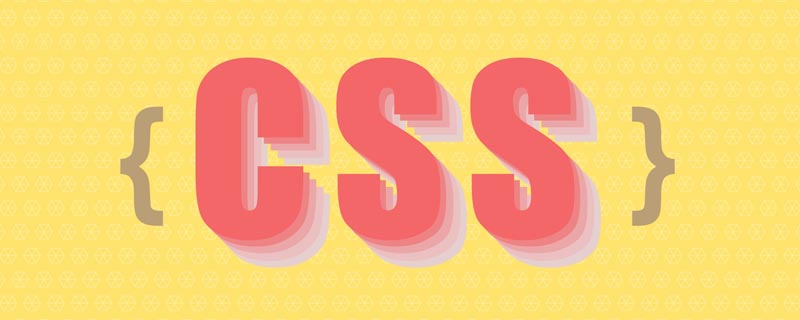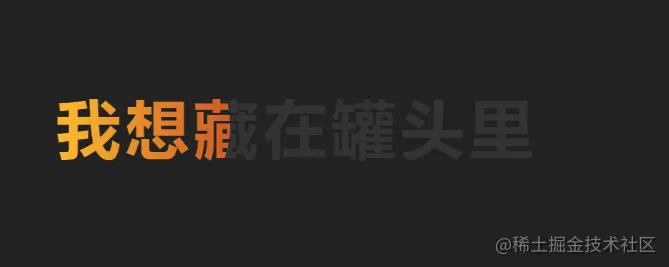How to create a spotlight effect using CSS (code attached)
How to use CSS to create a spotlight effect? The following article will analyze the implementation principle and share the implementation code of CSS spotlight effect. I hope it will be helpful to everyone!

The implementation principle of CSS spotlight effect is very simple:
- Completely overlap the two texts, the inner layer is dark gray, and the outer layer is Gradient color. [Recommended learning: css video tutorial]
- Apply a circular mask to the outer text.
- Add
CSS Animationat the end.
Technical Support
The referenced CSS properties are:
implementation
In order to keep the HTML structure simple, pseudo-class elements will be used later.
HTML code is as follows:
<h1 id="我想藏在罐头里">我想藏在罐头里</h1>
Note:
attr()Theoretically it can be used for all CSS properties but currently supported Only thecontentattribute of the pseudo-element, other attributes and advanced features are currently experimentalTranslator's Note: If you find that the browser is compatible with attr( ) still does not have good support, most of the content of this article is just talk on paper
QuoteMDN document
The CSS code is as follows:
*{
margin: 0;
padding: 0;
}
:root{
--ellipse: 6.25rem;
}
html, body{
display: flex;
justify-content: center;
align-items: center;
height: 100vh;
background: #222;
}
h1{
font-size: 4rem;
color: #333;
width: 37.5rem;
position: relative;
}
h1::after{
/* attr(attribute_name) */
content:attr(data-text);
position: absolute;
top: 0;
left: 0;
color: pink;
clip-path: ellipse(var(--ellipse) var(--ellipse) at 0% 50%);
animation: move 5s infinite;
}
@keyframes move{
0%, 100%{
clip-path: ellipse(var(--ellipse) var(--ellipse) at 0% 50%);
}
50%{
clip-path: ellipse(var(--ellipse) var(--ellipse) at 100% 50%);
}
}The effect is as follows:

Now the dynamic spotlight effect is completed.
But there is still a problem. I wonder if my attentive friends have noticed it. The text in the finished product is color. The principle is to add a background image, and then use the text as a mask. Finally Change color to transparent, so we need to modify the code.
Add code background-image and background-clip in h1:after:
h1::after{
/* 别忘记修改color为透明 */
color: transparent;
background-image: linear-gradient(to left,#1a2a6c,#b21f1f,#fdbb2d);
background-clip: text;
/* 因为background-clip是预览阶段的css属性,要加上一个前缀版本 */
-webkit-background-clip: text;
}Look at the final The finished effect:

The source code of the demonstration is here CodePen link:
https://codepen.io/jackbrens/pen/MWrGNed
Summary
The above is the entire content of this sharing~~
If you think the article is well written and has inspired you, please don’t be stingy. Like and Follow and leave your valuable opinions in the comment area~~
(Learning video sharing: web front end)
The above is the detailed content of How to create a spotlight effect using CSS (code attached). For more information, please follow other related articles on the PHP Chinese website!

Hot AI Tools

Undresser.AI Undress
AI-powered app for creating realistic nude photos

AI Clothes Remover
Online AI tool for removing clothes from photos.

Undress AI Tool
Undress images for free

Clothoff.io
AI clothes remover

Video Face Swap
Swap faces in any video effortlessly with our completely free AI face swap tool!

Hot Article

Hot Tools

Notepad++7.3.1
Easy-to-use and free code editor

SublimeText3 Chinese version
Chinese version, very easy to use

Zend Studio 13.0.1
Powerful PHP integrated development environment

Dreamweaver CS6
Visual web development tools

SublimeText3 Mac version
God-level code editing software (SublimeText3)

Hot Topics
 1673
1673
 14
14
 1428
1428
 52
52
 1333
1333
 25
25
 1278
1278
 29
29
 1257
1257
 24
24
 How to use bootstrap in vue
Apr 07, 2025 pm 11:33 PM
How to use bootstrap in vue
Apr 07, 2025 pm 11:33 PM
Using Bootstrap in Vue.js is divided into five steps: Install Bootstrap. Import Bootstrap in main.js. Use the Bootstrap component directly in the template. Optional: Custom style. Optional: Use plug-ins.
 Understanding HTML, CSS, and JavaScript: A Beginner's Guide
Apr 12, 2025 am 12:02 AM
Understanding HTML, CSS, and JavaScript: A Beginner's Guide
Apr 12, 2025 am 12:02 AM
WebdevelopmentreliesonHTML,CSS,andJavaScript:1)HTMLstructurescontent,2)CSSstylesit,and3)JavaScriptaddsinteractivity,formingthebasisofmodernwebexperiences.
 The Roles of HTML, CSS, and JavaScript: Core Responsibilities
Apr 08, 2025 pm 07:05 PM
The Roles of HTML, CSS, and JavaScript: Core Responsibilities
Apr 08, 2025 pm 07:05 PM
HTML defines the web structure, CSS is responsible for style and layout, and JavaScript gives dynamic interaction. The three perform their duties in web development and jointly build a colorful website.
 How to insert pictures on bootstrap
Apr 07, 2025 pm 03:30 PM
How to insert pictures on bootstrap
Apr 07, 2025 pm 03:30 PM
There are several ways to insert images in Bootstrap: insert images directly, using the HTML img tag. With the Bootstrap image component, you can provide responsive images and more styles. Set the image size, use the img-fluid class to make the image adaptable. Set the border, using the img-bordered class. Set the rounded corners and use the img-rounded class. Set the shadow, use the shadow class. Resize and position the image, using CSS style. Using the background image, use the background-image CSS property.
 How to write split lines on bootstrap
Apr 07, 2025 pm 03:12 PM
How to write split lines on bootstrap
Apr 07, 2025 pm 03:12 PM
There are two ways to create a Bootstrap split line: using the tag, which creates a horizontal split line. Use the CSS border property to create custom style split lines.
 How to set up the framework for bootstrap
Apr 07, 2025 pm 03:27 PM
How to set up the framework for bootstrap
Apr 07, 2025 pm 03:27 PM
To set up the Bootstrap framework, you need to follow these steps: 1. Reference the Bootstrap file via CDN; 2. Download and host the file on your own server; 3. Include the Bootstrap file in HTML; 4. Compile Sass/Less as needed; 5. Import a custom file (optional). Once setup is complete, you can use Bootstrap's grid systems, components, and styles to create responsive websites and applications.
 How to resize bootstrap
Apr 07, 2025 pm 03:18 PM
How to resize bootstrap
Apr 07, 2025 pm 03:18 PM
To adjust the size of elements in Bootstrap, you can use the dimension class, which includes: adjusting width: .col-, .w-, .mw-adjust height: .h-, .min-h-, .max-h-
 How to use bootstrap button
Apr 07, 2025 pm 03:09 PM
How to use bootstrap button
Apr 07, 2025 pm 03:09 PM
How to use the Bootstrap button? Introduce Bootstrap CSS to create button elements and add Bootstrap button class to add button text




